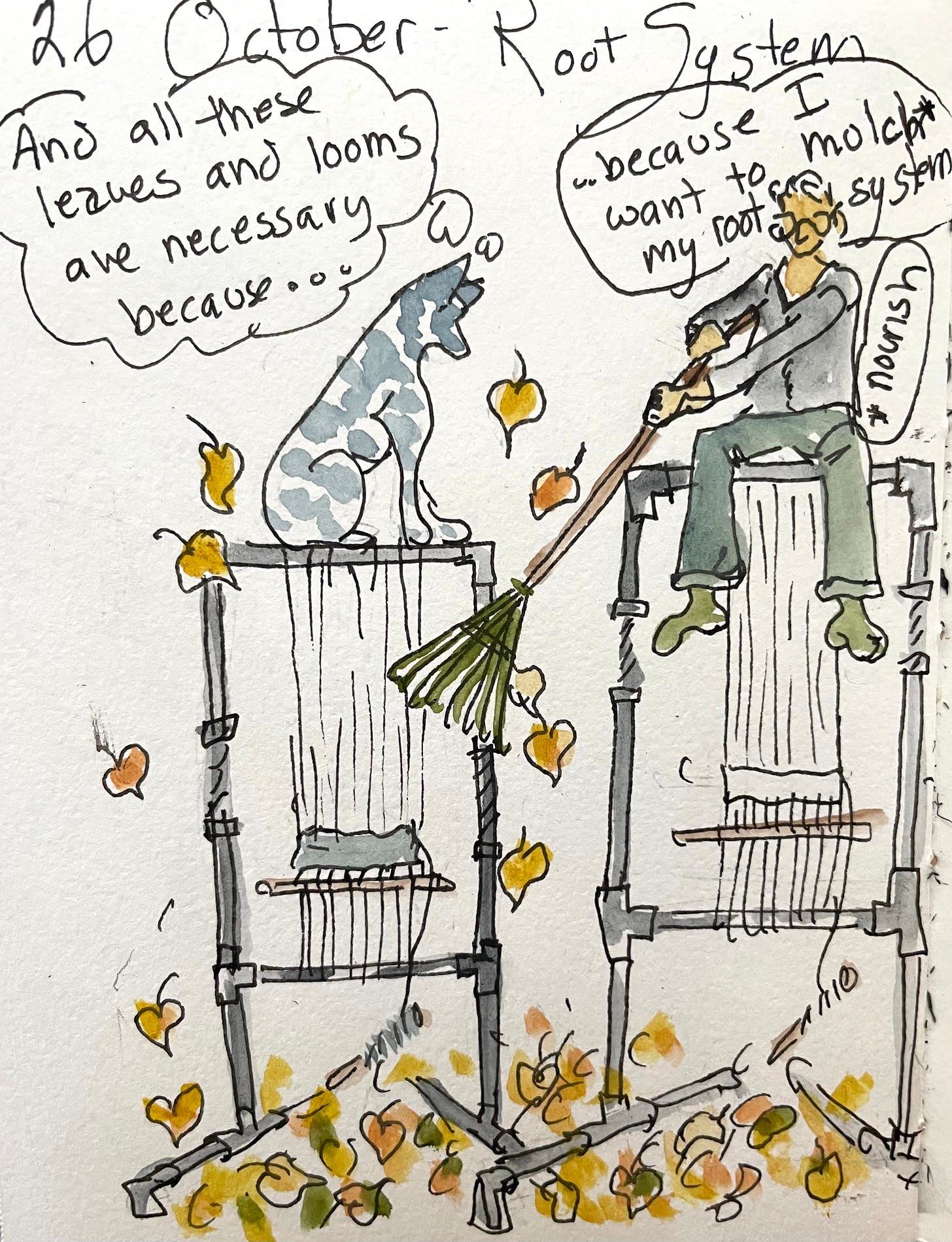Hold on Sarah.
Wait just a second. You’re honestly weaving your way up two separate continuous warps— at the same time?
Isn’t that a little much—especially when (so you say), you’re trying so hard to use up, clear out and simplify?
How ever does winding another warp fit into that idea?
Geez. I don’t know. I hardly had time to think, really. It just… happened.
One minute I was going about my ordinary tasks—
—and the next I was gathering loom parts and playing warp chicken in the autumn sun.1




Truly— it wasn’t intentional.
Except, you know, once I was that far along it would have been silly to go do some sensible thing, especially when Beryl was all comfy.
So I went ahead and adjusted the tension2—
—made heddles3—
—anchored the sett with twining and double-half-hitches—
— and started weaving.4
Truth to tell I did have the semblance of a plan when I began. I was going to make a word-centric diptych and the panels felt like they needed to be woven at the same time.5
But of course now that I’m actually sitting between the looms and tapping weft into place, I find that the warps themselves may not be into either words or diptychs. And if they are, it is still a thing each of them gets to decide. Indeed for all that they appear to be amicable, and for all that I appear to believe that each interlacement of warp and weft will somehow help all of us become more amicable—
— or at least will help bring a glimmer of congenial light to my corner of the world —
—the looms themselves remind me (once again) that my task is not to impose but to notice.
Mine, simply enough, is to plop my butt on the cushioned box between those galvanized rectangles, choose a direction (they are surprisingly agreeable about taking turns), open a shed, offer yarn and learn with each pass how things will unfold.6 It’s not how things were in the old days when drawing cartoons and planning ahead was all the rage.7




But honestly, scary as it is, this is even more interesting.
So when one of them declared that the way to begin was to head eccentrically up and over a smooth grey hill—well Beryl and I were all in favor.
And off we went.8
The white warp used up the last of a mini-cone of 2 ply wool warp I bought years ago at Halcyon Yarn, so when I decided to wind this second one it made sense to use the last of the grey I’d purchased at the same time (so satisfying to use things up). I didn’t weigh or measure either cone, but hoped the warps would turn out to be approximately the same size. Alas, I didn’t quite make it as the grey ran out five warps shy of the white width, but it was close enough to be satisfying.
I so love the sound of the warp as it slips around the wooden bar. And that’s a good thing because getting the tension nice and even at this point is a huge kindness to future Sarah who, weeks hence, will be most grateful!
As perhaps you can tell, I’m aiming to produce an even amount of tension as I pull each strand: nothing super tight for I can adjust the entire warp later with the tensioning devises on the loom (threaded rod and nuts).
I don’t bother to make heddles when I weave small tapestries, but with a continuous warp that I’m likely to be working on for a while, it is totally worth it. It turns out that almost exactly a year ago I wrote a Substack post all about leashes and heddles and such: A Good Shed is Hard to Find , so if you want to know more, check it out.
Are autumnal continuous warps a thing and I didn’t even notice?
Wool warp and weft. The bliss of it. So forgiving—though after mostly working with paper, milkweed, cotton and linen, I find I do have to pay extra attention to my bubbling. There’s not a ton of stretch in this weft, but it is wool and will almost always have more bounce than in any of those other fibers.
Like simultaneously knitting the sleeves on a sweater, the cuffs on a pair of socks or the thumbs on mittens, doing two things at once can help prevent both project fatigue and the horror of forgetting where the increase and decreases (or warp shapes) need to be.
These desires are beautifully addressed here by the oh-so-creatively-thoughtful Anna Brones, and here with the fairy-tale miracle words of Sharon Blackie.
My old days anyway!
As a somewhat slanted and (so it seems), slightly eccentric person, eccentric weft can be irresistible. The Ups and Downs of Tapestry is a blog post I wrote many years ago about a way to build smooth curves and weave eccentrically over the top of them.
It’s always wild to come upon these old posts and come upon what were then the latest examples of my work. How ever did I do all that? A pick at a time Sarah. A pick at a time.





















That was satisfying to read.
Not sure if the wee grey hill found you, or you found it ... But I do like it!